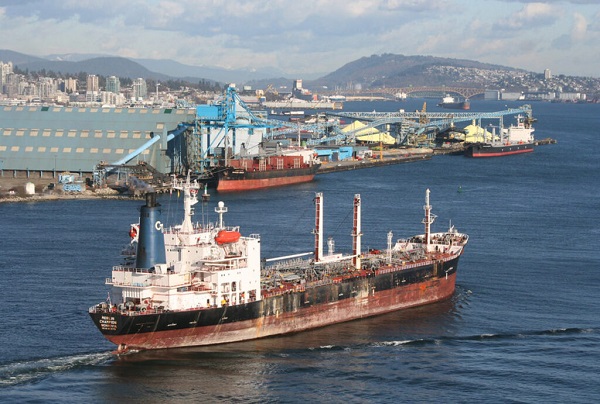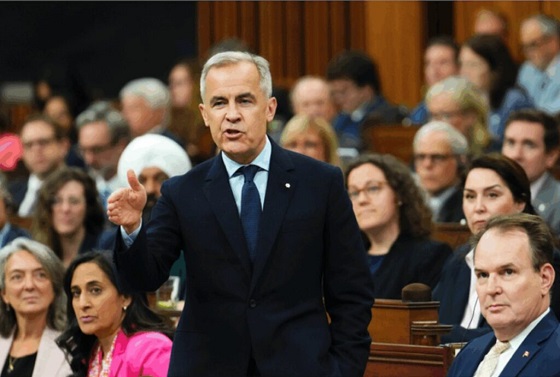Energy
TMX Pipeline a Success Story – Despite All the Green Battles Against It

From Energy Now
“As we go into winter months, Canada will set new export records”
We remember well the green battles against the “TMX” expansion of the Trans Mountain oil pipeline from Alberta to B.C. The idea was, they said, at best unnecessary and at worst thoroughly dangerous to the world environment.
One group said the expansion “threatens to unleash a massive tar sands spill that would threaten drinking water, salmon, coastal wildlife, and communities.” It would also, others said, impede investment in clean energy and undermine Canada’s efforts to deal with climate change.
Some said the expanded line would be an imposition on First Nations. But a number of First Nations are interested in acquiring an equity stake in the pipeline (and the federal government, which owns the line, is looking to sell a 30-percent stake to them).
Despite the loud opposition, the federal government went ahead and purchased the pipeline and the expansion project in May 2018, completing the pipeline’s expansion this year at a total cost of $31 billion.
Prime Minister Trudeau’s explanation: Ottawa stepped in because owner Kinder Morgan “wanted to throw up their hands and walk away,” and his government wanted to make sure that Canadian oil could reach new markets.
Alberta’s Canadian Energy Centre supported that outlook: “We’re going to be moving into a market where buyers are going to be competing to buy Canadian oil.”
Our Margareta Dovgal wrote: “What matters to us is the benefits to Canada. For one thing, we now will be able to ship more oil by tanker to refineries on the U.S. West Coast at a better price than oil by tanker from Alaska. And . . . we’ll have more oil more readily available for overseas buyers.
“So, all in all, we can expect to see higher returns on our oil, and we can continue to see the immense benefits of high-paying jobs in Canadian energy, and the benefits of revenues to government.”
It has all been happening, in spades.
And the opening of the expanded pipeline on May 1 this year also helped bring down gasoline prices.
In Vancouver, for example, regular gasoline in April ran as high as $2.359 a litre. At the beginning of May, as key refineries returned to normal after seasonal maintenance work, it stood around $2.085. As October opened, the price was as low as $1.579.
Economist G. Kent Fellows said at an event hosted by Resource Works and the Business Council of B.C.: “Our analysis shows that insufficient pipeline capacity was costing B.C. consumers an estimated $1.5 billion per year in higher gasoline prices.
“With TMX now operational, wholesale gasoline prices in Vancouver dropped by about 28 cents per litre compared to earlier this year.”
As for those buyers competing for our oil, some thought the prime export destination would be California. But the summer just past brought exports on tankers from Vancouver to China, Japan, India, Hong Kong, South Korea, and Brunei.
As of now, California is indeed leading as a destination, with Asian buyers having eased off after their initial purchases. Experts say that was expected, with Asian refineries first taking test cargoes to see how their systems handle our oil.
Kevin Birn, chief Canadian oil markets analyst for S&P Global, told Business in Vancouver: “There is always a market for crude oil in the Pacific Basin. We always saw the need for the Trans Mountain pipeline. We saw Canadian production continuing to grow.”
Birn added: “It’s still relatively early. I’d expect volumes to continue to build, cargoes to test different markets all over the place, and over time you’ll start to see patterns.
“As we go into winter months, Canada will set new export records, because as capacity’s been optimized and new product projections and wells are brought online, the winter tends to be the peak period.
“Every year, I think, for the next couple of years, Canada will set new records.”
That would be good news for Canada’s economy — and for Alberta’s.
There are no statistics available yet on the TMX line’s impact on the economy, but in 2019 Trans Mountain estimated that construction and operation would mean $46 billion in revenue to governments over the first 20 years.
Today, as reported by Alberta’s energy minister, Brian Jean, Alberta continues to break records for crude oil production, with global demand continuing to grow.
The latest numbers from the Alberta Energy Regulator show Alberta’s oil production averaged a little over 4 million barrels per day in August — the highest on record for any August.
“The addition of 590,000 barrels per day of heavy oil pipeline capacity from Alberta to the B.C. coast earlier this year with the completion of the Trans Mountain Pipeline expansion project has been instrumental in the recent production increases.”
All this as the International Energy Agency said that while oil demand is decelerating from 2023 levels due to a slowing economy in China, demand is still set to increase by 900,000 barrels per day (bpd) this year. That would push global consumption to a record level of almost 103 million bpd.
And that forecast came as Jonathan Wilkinson, our federal minister of energy and natural resources, declared: “Oil and gas will peak this decade. In fact, oil is probably peaking this year.”
A bevy of market-watchers disagreed with him. Among them, Greg Ebel, CEO of Calgary-based Enbridge, says global oil consumption will be “well north” of 100 million barrels per day by 2050 — and could exceed 110 million barrels.
“You continue to see economic demands, and particularly in the developing world, people continue to say lighter, faster, denser, cheaper energy works for our people. . . And that’s leading to more oil usage.”
Energy
Liberals Twisted Themselves Into Pretzels Over Their Own Pipeline MOU

From Energy Now
By Margareta Dovgal
Playing politics with pipelines is a time-honored Canadian tradition. Recent events in the House of Commons offered a delightful twist on the genre.
The Conservatives introduced a motion quoting the Liberals’ own pipeline promises laid out in the Memorandum of Understanding (MOU) with Alberta, nearly verbatim. The Liberals, true to form, killed it 196–139 with enthusiastic help from the NDP, Bloc, and Greens.
We all knew how this would end. Opposition motions like this never pass; no government, especially not one led by Mark Carney, is going to let the opposition dictate the agenda. There’s not much use feigning outrage that the Liberals voted it down. The more entertaining angle has been watching closely as Liberal MPs twist themselves into pretzels explaining why they had to vote “no” on a motion that cheers on a project they claim to support in principle.
Liberal MP Corey Hogan dismissed the motion as “game-playing” designed to “poke at people”.
And he’s absolutely right to call it a “trap” for the Liberals. But traps only work when you walk into them.
Indigenous Services Minister Mandy Gull-Masty deemed the motion an “immature waste of parliamentary time” and “clearly an insult towards Indigenous Peoples” because it didn’t include every clause of the original agreement. Energy Minister Tim Hodgson decried it as a “cynical ploy to divide us” that “cherry-picked” the MOU.
Yet the prize for the most tortured metaphor goes to the prime minister himself. Defending his vote against his own pipeline promise, Carney lectured the House that “you have to eat the entire meal, not just the appetizer.”
It’s a clever line, and it also reveals the problem. The “meal” Carney is serving is stuffed with conditions. Environmental targets or meaningful engagement with Indigenous communities aren’t unrealistic asks. A crippling industrial carbon price as a precondition might be though.
But the prime minister has already said the quiet part out loud.
Speaking in the House a few weeks ago, Carney admitted that the agreement creates “necessary conditions, but not sufficient conditions,” before explicitly stating: “We believe the government of British Columbia has to agree.”
There is the poison pill. Handing a de facto veto to a provincial government that has spent years fighting oil infrastructure is neither constitutionally required nor politically likely. Elevating B.C.’s “agreement” to a condition, which is something the MOU text itself carefully avoids doing, means that Carney has made his own “meal” effectively inedible.
Hodgson’s repeated emphasis that the Liberal caucus supports “the entire MOU, the entire MOU” only reinforces this theory.
This entire episode forces us to ask whether the MOU is a real plan to build a pipeline, or just a national unity play designed to cool down the separatist temperature in Alberta. My sense is that Ottawa knew they had to throw a bone to Premier Danielle Smith because the threat of the sovereignty movement is gaining real traction. But you can’t just create the pretense of negotiation to buy time.
With the MOU getting Smith boo’ed at her own party’s convention by the separatists, it’s debatable whether that bone was even an effective one to throw.
There is a way. The federal government has the jurisdiction. If they really wanted to, they could just do it, provided the duty to consult with and accommodate Indigenous peoples was satisfied. Keep in mind: no reasonable interpretation equates Section 35 of the Charter to a veto.
Instead, the MOU is baked with so many conditions that the Liberals have effectively laid the groundwork for how they’re going to fail.
With overly-hedged, rather cryptic messaging, Liberals have themselves given considerable weight to a cynical theory, that the MOU is a stalling tactic, not a foundation to get more Canadian oil to the markets it’s needed in. Maybe Hodgson is telling the truth, and caucus is unified because the radicals are satisfied that “the entire MOU” ensures that a new oil pipeline will never reach tidewater through BC.
So, hats off to the legislative affairs strategists in the Conservative caucus. The real test of Carney’s political power continues: can he force a caucus that prefers fantasy economics into a mold of economic literacy to deliver on the vision Canadians signed off on? Or will he be hamstrung trying to appease the radicals from within?
Margareta Dovgal is managing director of Resource Works Society.
Daily Caller
Paris Climate Deal Now Decade-Old Disaster


From the Daily Caller News Foundation
By Steve Milloy
The Paris Climate Accord was adopted 10 years ago this week. It’s been a decade of disaster that President Donald Trump is rightly trying again to end.
The stated purpose of the agreement was for countries to voluntarily cut emissions to avoid the average global temperature exceeding the (guessed at) pre-industrial temperature by 3.6°F (2°C) and preferably 2.7°F (1.5°C).
Since December 2015, the world spent an estimated $10 trillion trying to achieve the Paris goals. What has been accomplished? Instead of reducing global emissions, they have increased about 12 percent. While the increase in emissions is actually a good thing for the environment and humanity, spending $10 trillion in a failed effort to cut emissions just underscores the agreement’s waste, fraud and abuse.
As a nonprofit, we are dependent on the generosity of our readers.
Please consider making a small donation of any amount here.
Thank you!
But wasting $10 trillion is only the tip of the iceberg.
The effort to cut emissions was largely based on forcing industrial countries to replace their tried-and-true fossil fuel-based energy systems with not-ready-for-prime-time wind, solar and battery-based systems. This forced transition has driven up energy costs and made energy systems less reliable. The result of that has been economy-crippling deindustrialization in former powerhouses of Germany and Britain.
And it gets worse.
European nations imagined they could reduce their carbon footprint by outsourcing their coal and natural gas needs to Russia. That outsourcing enriched Russia and made the European economy dependent on Russia for energy. That vulnerability, in turn, and a weak President Joe Biden encouraged Vladimir Putin to invade Ukraine.
The result of that has been more than one million killed and wounded, the mass destruction of Ukraine worth more than $500 billion so far and the inestimable cost of global destabilization. Europe will have to spend hundreds of billions more on defense, and U.S. taxpayers have been forced to spend hundreds of billions on arms for Ukraine. Putin has even raised the specter of using nuclear weapons.
President Barack Obama unconstitutionally tried to impose the Paris agreement on the U.S. as an Executive agreement rather than a treaty ratified by the U.S. Senate. Although Trump terminated the Executive agreement during his first administration, President Joe Biden rejoined the agreement soon after taking office, pledging to double Obama’s emissions cuts pledge to 50 percent below 2005 levels by 2030.
Biden’s emissions pledge was an impetus for the 2022 Inflation Reduction Act that allocated $1.2 trillion in spending for what Trump labeled as the Green New Scam. Although Trump’s One Big Beautiful Bill Act reduced that spending by about $500 billion and he is trying to reduce it further through Executive action, much of that money was used in an effort to buy the 2024 election for Democrats. The rest has been and will be used to wreck our electricity grid with dangerous, national security-compromising wind, solar and battery equipment from Communists China.
Then there’s this. At the Paris climate conference in 2015, U.S. Secretary of State John Kerry stated quite clearly that emissions cuts by the U.S. and other industrial countries were meaningless and would accomplish nothing since the developing world’s emissions would be increasing.
Finally, there is the climate realism aspect to all this. After the Paris agreement was signed and despite the increase in emissions, the average global temperature declined during the years from 2016 to 2022, per NOAA data.
The super El Nino experienced during 2023-2024 caused a temporary temperature spike. La Nina conditions have now returned the average global temperature to below the 2015-2016 level, per NASA satellite data. The overarching point is that any “global warming” that occurred over the past 40 years is actually associated with the natural El Nino-La Nina cycle, not emissions.
The Paris agreement has been all pain and no gain. Moreover, there was never any need for the agreement in the first place. A big thanks to President Trump for pulling us out again.
Steve Milloy is a biostatistician and lawyer. He posts on X at @JunkScience.
-

 Business2 days ago
Business2 days agoOttawa Pretends To Pivot But Keeps Spending Like Trudeau
-

 International2 days ago
International2 days agoBondi Beach Shows Why Self-Defense Is a Vital Right
-

 Crime1 day ago
Crime1 day agoBondi Beach Survivor Says Cops Prevented Her From Fighting Back Against Terrorists
-

 Automotive1 day ago
Automotive1 day agoFord’s EV Fiasco Fallout Hits Hard
-

 Energy2 days ago
Energy2 days agoLiberals Twisted Themselves Into Pretzels Over Their Own Pipeline MOU
-

 Censorship Industrial Complex2 days ago
Censorship Industrial Complex2 days agoHow Wikipedia Got Captured: Leftist Editors & Foreign Influence On Internet’s Biggest Source of Info
-

 Crime2 days ago
Crime2 days agoThe Uncomfortable Demographics of Islamist Bloodshed—and Why “Islamophobia” Deflection Increases the Threat
-

 Frontier Centre for Public Policy17 hours ago
Frontier Centre for Public Policy17 hours agoCanada Lets Child-Porn Offenders Off Easy While Targeting Bible Believers






